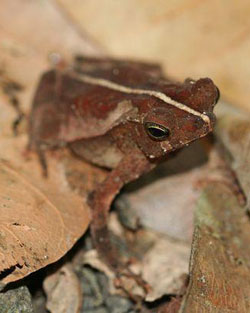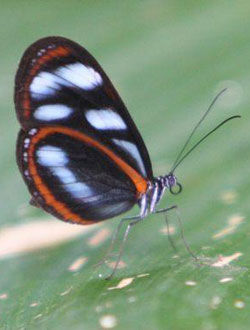Primary rainforest richer in species than plantations, secondary forests
Forest disturbance reduces biodiversity in the Amazon rainforest
Primary rainforest richer in species than plantations, secondary forests
Rhett A. Butler, mongabay.com
July 2, 2007
Two new studies in the Amazon rainforest show that plantation forests and second-growth forests have lower species counts for butterflies, reptiles, and amphibians than adjacent primary forest areas. The research has important implications for conservation of tropical biodiversity in a world where old-growth forest is increasingly replaced by secondary forests, industrial plantations, and agricultural landscapes.
Both studies were conducted in the Jari River border region between the states of Pará and Amapá, an area of the Brazilian Amazon where large tracts of forest were cleared and converted for cellulose pulp production plantations in the 1960s. Today some of these plantations have been abandoned and secondary forest has subsequently regrown, while other plantations are still active. Surrounding these lands are undisturbed rainforests. The matrix of forest types serves as a prime area for studying differences in biodiversity between undisturbed, regenerating, and plantation forests.
 Plantations are biologically impoverished from a biodiversity standpoint relative to primary forests. Photo by R. Butler |
Lizards and frogs: more diverse in virgin rainforest
The first study, published in Conservation Biology by a team of researchers lead by Toby A. Gardner of the University of East Anglia, focused on reptiles and amphibians inhabiting forest leaf litter. Collecting 1739 leaf-litter amphibians (23 species) and 1937 lizards (30 species) during a 2-year period using four sampling methods, the researchers found that “primary rainforest harbored significantly more species, but supported a similar abundance of amphibians and lizards compared with adjacent areas of second-growth forest or plantations.”
The researchers say plantation forests are dominated by wide-ranging habitat generalist species, while secondary forests contained a number of species characteristic of primary forest habitat.
Butterflies: rarer but richer in primary forests
The second study, published in The Journal of Applied Ecology and led by Jos Barlow of the University of East Anglia, focused on differences in butterfly biodiversity between primary tropical forest, plantations, and regenerating secondary forests.
 Photo by R. Butler |
Recording 10,587 butterflies and 128 species in 3,200 trap-days. the researchers found that “species richness was highest in primary forest and lowest in plantations,” but that overall butterfly abundance was higher in non-natural forest areas. The results indicate that species resident in plantations are abundant but common, while secondary forests were sometimes richer in butterfly biodiversity than primary forest, depending on the season.
“Secondary forest exhibited higher observed richness than primary forest in the peak of the dry-season, but not at other times of the year,” wrote the authors. “This observation could explain the lack of consensus in previous studies, as those reporting higher richness in secondary forest only sampled during the dry-season.”
Overall, the findings from the two studies suggest that plantations and natural forest regeneration in abandoned lands may not “provide refuge for the many species that are currently threatened by deforestation,” wrote Gardner and colleagues. The results are important given that more than 15 million hectares of forest were destroyed each year during the 1990s, while secondary forests have replaced one-sixth of all tropical primary forests that were felled during that time. Meanwhile, tropical forest plantations expanded by almost 5-fold since 1980.
The authors note that these trends, coupled with the “inadequacy of the global protected-area networks means that the future of many tropical forest species will depend in part on their conservation in human-dominated landscapes.”
Via email with mongabay.com, Gardner adds, “Understanding the extent to which the loss of native forest signifies the loss of old-growth species is one of the most significant challenges facing conservation science in the beleaguered tropics. There are still pitifully few data available that can provide robust answers to this question, yet without such information we will remain unable to translate the consequences of deforestation into changes in biodiversity”.
CITATIONS: Toby A. Gardner, Marco Antonio Ribeiro-Junior, Jos Barlow, Teresa Cristina Sauer Avila-Pires, Marinus S. Hoogmoed, and Carlos A. Peres (2007). The Value of Primary, Secondary, and Plantation Forests for a Neotropical Herpetofauna. Conservation Biology Volume 21, No. 3, 775-787
Jos Barlow, William L. Overal, Ivanei S. Araujo, Toby A. Gardner and Carlos A. Peres (2007). The value of primary, secondary and plantation forests for fruit-feeding butterflies in the Brazilian Amazon. Journal of Applied Ecology 2007